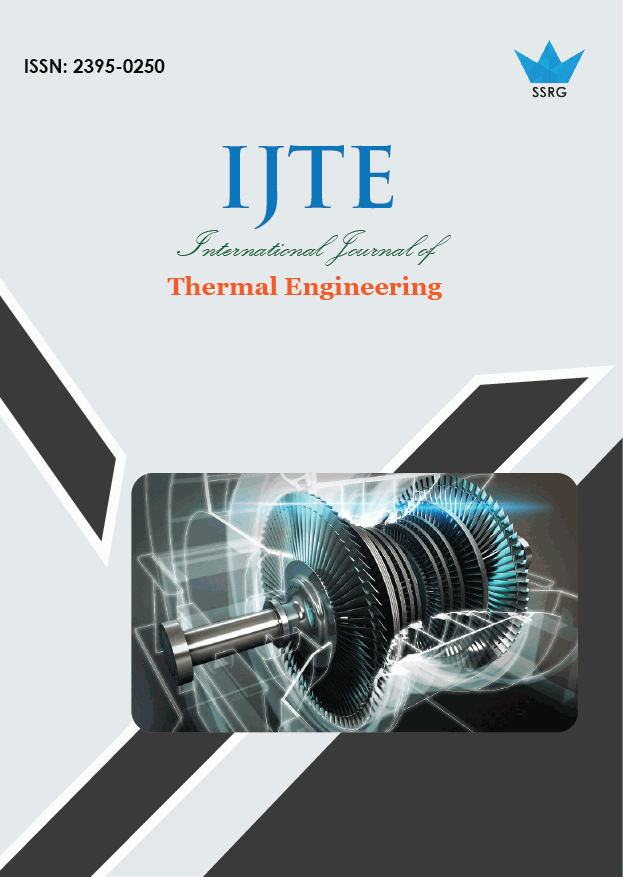Variations of Air and Water Temperatures Across and Along the Pads of Direct Evaporative Coolers and Their Effect on the Performance

| International Journal of Thermal Engineering |
| © 2016 by SSRG - IJTE Journal |
| Volume 2 Issue 3 |
| Year of Publication : 2016 |
| Authors : M. Mosa, A. Saleh |
How to Cite?
M. Mosa, A. Saleh, "Variations of Air and Water Temperatures Across and Along the Pads of Direct Evaporative Coolers and Their Effect on the Performance," SSRG International Journal of Thermal Engineering, vol. 2, no. 3, pp. 1-8, 2016. Crossref, https://doi.org/10.14445/23950250/IJTE-V2I6P101
Abstract:
This paper presents the effect of variations of air and water temperatures across and along the pads of direct evaporative coolers and their effect on the performance. Two thicknesses of a (60cm × 76cm) pad are considered in this study. It is found that, for the thickness of 10 cm, variation of air temperature across the pad varies from 3.7 degrees at the top to 7.4 degrees at the bottom of the pad. For the thickness of 15 cm, variation of air temperature across the pad varies from 6.3 degrees at the top to 10.57 degrees at the bottom of the pad. It was found, also, that the profiles of the air temperature at the lower sectors of the pad are almost identical. The variation of water temperature across the pad was insignificant in the two cases considered. These results are used in optimization of the dimensions of the pad that maximize the performance of the cooler. The optimal thickness is restricted by the acceptable upper limit of relative humidity. It was found that with 70% relative humidity, the optimal thickness was 15 cm while with 85% relative humidity, the optimal thickness was 25 cm.
Keywords:
direct evaporative cooler, cooler pad, heat and mass transfer, cooling efficiency.
References:
[1] S. S. Kachhwaha and Suhas Prabhakar, “Heat and mass transfer study in a direct evaporative cooler,” Journal of Scientific & Industrial Research, vol. 69, pp. 705-710, 2010.
[2] Jose´ Rui Camargoa, Carlos Daniel Ebinumab and Jose´ Luz Silveirab. “Experimental performance of a direct evaporative cooler operating during summer in a Brazilian city,” International Journal of Refrigeration, vol. 28, pp. 1124–1132, 2005.
[3] J. R. Camargo, D. C. Ebinuma and S. Cardoso, “A mathematical model for direct evaporative cooling air conditioning system,” Engenharia Térmica, vol. 3, pp. 30- 34, 2003.
[4] R. K. Kulkarni and S. P. S. Rajput, “Comparative performance of evaporative cooling pads of alternative materials,” International Journal of Advanced Engineering Sciences and Technologies (IJAEST), vol. 10(2), pp. 239- 244, 2011.
[5] J. M. Wu, X. Huang and H. Zhang, “Theoretical analysis on heat and mass transfer in a direct evaporative cooler,” Applied Thermal Engineering, vol. 29, pp. 980-984, 2009.
[6] M. S. Sodha and A. Somwanshi, “Variation of water temperature along the direction of flow: effect on performance of an evaporative cooler,” Journal of Fundamentals of Renewable Energy and Applications, vol. 2, pp 1-6, 2012.
[7] Metin Dagtekin, Cengiz Karaca, Y. ilmaz Yildiz, Ali Bascetinçelik and Ömer Paydak, “The effects of air velocity on the performance of pad evaporative cooling systems,” African Journal of Agricultural Research, vol. 6(7), pp. 1813-1822, 2011.
[8] Y. J. Dai and K. Sumathy, “Theoretical study on a crossflow direct evaporative cooler using honeycomb paper as packing material,” Applied Thermal Engineering, vol. 22, pp. 1417–1430, 2002.
[9] J. M. Wu, X. Huang and H. Zhang, “Numerical investigation on the heat and mass transfer in a direct evaporative cooler,” Applied Thermal Engineering, vol. 29, pp. 195–201, 2009.
[10] G. N. Tiwari, Solar Energy Fundamentals, Design Modelling and Applications, New Delhi, India: Narosa Publishing House, 2002.

 10.14445/23950250/IJTE-V2I6P101
10.14445/23950250/IJTE-V2I6P101